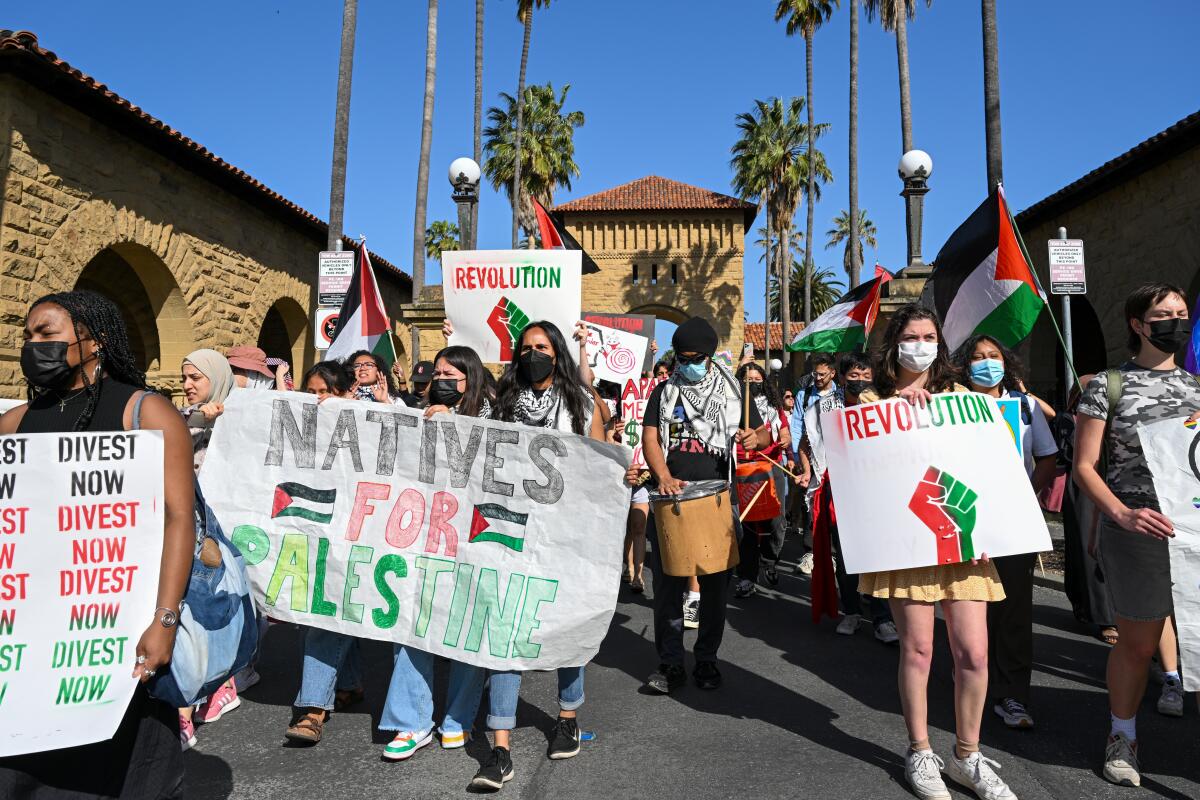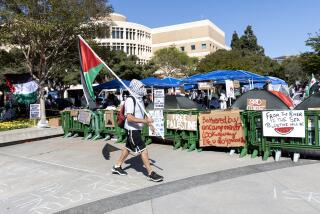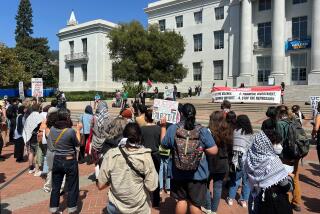Stanford protesters arrested, seniors won’t be allowed to graduate, officials say

Stanford University plans to immediately suspend students who were among 13 pro-Palestinian protesters arrested Wednesday morning after a brief occupation of the president’s office. College officials said activists illegally entered a building, injured a law enforcement officer and carried out “extensive damage” to buildings in its historic quad.
Before 6 a.m. on the last day of spring classes, a small group of students and alumni barricaded themselves inside President Richard Saller’s office , vowing they would not leave until administrators met their demands to divest from Israel.
The occupation lasted less than two hours. At around 7:30 a.m. — as protesters outside chanted “Free, Free Palestine” — law enforcement officers broke open a door with a crowbar and entered the building.
By 8 a.m., police from the Santa Clara Sheriff’s Office and Stanford University Dept. of Public Safety had cleared the building of protesters. Stanford University announced that 13 students were arrested, the building had been cleared and a public safety officer was injured by protesters, who shoved the officer as they “interfered with a transport vehicle.”
The Stanford Daily reported that one of its reporters was among the detained.
In a statement, the university said the activists “unlawfully entered” the building that houses the offices of the president and provost.
“We are appalled that our students chose to take this action and we will work with law enforcement to ensure that they face the full consequences allowed by law,” university spokesperson Dee Mostofi said.
“All arrested students will be immediately suspended and in case any of them are seniors, they will not be allowed to graduate,” Mostofi added. “We have consistently emphasized the need for constructive engagement and peaceful protest when there is a disagreement in views. This was not peaceful protest and actions such as what occurred this morning have no place at Stanford.”
The student protesters, in turn, claimed police used excessive force.
Liberate Stanford, an autonomous group of Stanford University students that organized the occupation, accused law enforcement of “violently assault[ing] a peaceful student protester” as officers prepared to enter the building. It posted a video on Instagram showing a sheriff’s deputy in a helmet and tactical gear shoving back a student with a baton.
After the students were arrested, the university shut down activists’ encampment at White Plaza, which officials had allowed to remain even though they said it violated university policies on overnight camping, equitable access to the plaza and use of amplified sound.
“The situation on campus has now crossed the line from peaceful protest to actions that threaten the safety of our community,” Saller and provost Jenny Martinez said in a statement. “In the interest of public safety, the encampment has been removed.”
Wednesday’s occupation began before dawn as students barricaded themselves inside and renamed the building “Dr. Adnan’s office” in honor of Dr. Adnan al-Bursh, a leading Palestinian surgeon who died in April in an Israeli detention facility.
“THE STUDENT INT1FADA IS GROWING,” Liberate Stanford wrote in a statement on Instagram early Friday morning as the building was occupied. “We refuse to leave until Stanford Administration and the Stanford Board of Trustees meet our demands and take action to address their role in enabling and profiting from the ongoing genocide in Gaza.”
The protesters — who call themselves an autonomous group of students unaffiliated with any official student group — called on Stanford to add the divestment bill submitted by Stanford Against Apartheid in Palestine to the next Board of Trustees meeting, with a recommendation by Saller to support the bill, disclose finances from fiscal year 2022, and drop all disciplinary and criminal charges against pro-Palestinian students arrested on previous protests.
“If these demands are met, we will leave your office, President Saller,” an activist wearing sunglasses, a mask and a kaffiyeh said as she sat at a wooden desk inside the building in a video posted on Instagram by Liberate Stanford.
“I want you to think about your legacy,” she added. “No one is going to remember your historical research or your eight months as president. What they will remember is your silence and complicity in this genocide.”
After students occupied the president’s office, about 50 students — most wearing black with their faces wrapped in kaffiyehs — linked arms and surrounded the building in solidarity as the students occupied the building.
Some held a banner that read: “While Gaza bleeds Stanford stalls. Divest. Disclose. Amnesty.”
“We love you,” protesters shouted and cheered at the arrested activists as law enforcement escorted them from the building with their hands zip tied behind their backs.
“We see you! We love you!” they chanted. “We will be here to free you!”
Divisions swiftly emerged among the protesters after sandstone columns and buildings on the university’s historic main quad were spray painted and vandalized with slogans such as “DE@TH 2 ISR@HELL,” “Kill cops” and “PIGS TASTE BEST DEAD.”
In a statement, Liberate Stanford condemned activists who they claimed “took it upon themselves to spray paint or vandalize the outside of these buildings.”
“These are not the principles we abide by and these actions are disrespectful to the souls of the Palestinians who passed in their just struggle,” Liberate Stanford wrote. “The intentions of this movement are not to create unnecessary labor for service workers, and we refuse to have our uprising hijacked by unknown agitators.”
University leaders also spoke out against the graffiti, saying it conveyed “vile and hateful sentiments that we condemn in the strongest terms.”
The occupation comes after months of protests and negotiations between Stanford officials and pro-Palestinian activists. Last year, protesters set up a sprawling encampment, Sit-in to Stop Genocide, in White Plaza, which became the longest sit-in in Stanford history, until administrators enforced a camping ban in February “out of concern for the health and safety of our students.”
In April, activists set up another encampment in White Plaza. On May 20, a small group of demonstrators attempted to occupy a mechanical engineering building, blocking entryways with barricades and furniture. Saller told the faculty senate that students involved in that occupation faced “immediate suspension and the inability to participate in commencement” and may be subject to criminal charges.
More to Read
Sign up for Essential California
The most important California stories and recommendations in your inbox every morning.
You may occasionally receive promotional content from the Los Angeles Times.











